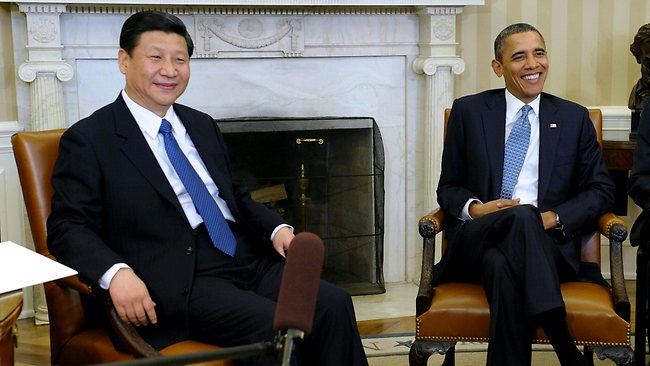The last couple weeks have concluded busy leadership contests. The two contemporary great powers of the international system – The United States and China – both have chosen new leadership. The methods could not be more different. Many observers have commented on the dramatic contrast. And the contrast is stark – Barack’s democratic national election voted on by millions upon millions of American citizens, as opposed to the backroom horse-trading by unelected Party seniors concluding shortly after the 18th Communist Party Congress, with the traditional march on stage of the seven – all men – Standing Committee Members of the Politburo.
But this yawning gap in the reliance on popular will and accountability is no surprise. This has been, and sadly continues to be, the CPC modus operandi. Nor is it a surprise to witness the dramatic electoral slog by sitting Presidents – all to the good – and the US contenders “dukeing” it out – in this instance President Obama and Governor Mitt Romney – and billions spent by both sides in this electoral contest. Instead let’s look at the expectations and consequences of the choices made.
Certainly, the reelection of Barack Obama keeps fixed in place – at least for now – the signature American foreign policy thrust – the rebalancing of US policy toward Asia – the so-called pivot. And indeed Obama’s first foreign sojourn has been to Asia and to the leaders EAS gathering in Phnom Penh. And on the way Obama – a son of Asia in part – visited Thailand and more startling – Burma – indeed the first American President to make such a visit. But it was at the EAS, the Leaders forum, where the United States made its presence known. One of the agreements signed was with the ASEAN, a key player in Asia, where the US and ASEAN signed the “Expanded Economic Initiative” or E3 -an agreement as the White House Press release declares is:
… a new framework for economic cooperation designed to expand trade and investment ties between the United States and ASEAN, creating new business opportunities and jobs in all eleven countries
ASEAN at this time has a combined GDP of USD$2.2 trillion and is the fourth largest export market for the US and largest trading partner overall.
But this agreement signals a more nuanced and sophisticated foreign policy. US policy has been so militarized over the last decades and in particular by the initiatives in Iraq and Afghanistan that many officials and observers fail to recognize today the critical nature of economic diplomacy. But the US rebalancing is not just about – and indeed possibly not primarily about – repositioning of forces, though this is important as well.
It is more than evident that foreign policy officials, especially Secretary of State Clinton see that US grand strategy is about – economic diplomacy. In fact just before the announcement of the E3 initiative between the US and ASEAN, Secretary Clinton delivered a speech at the Singapore Management University entitled, “Delivering on the Promise of Economic Statecraft.” This important speech includes the ‘startling’ admission that:
For the first time in modern history, nations are becoming major global powers without also becoming global military powers. So to maintain our strategic leadership in the region, the United States is also strengthening our economic leadership. And we know very well that America’s economic strength at home and our leadership around the world are a package deal. Each reinforces and requires the other.
Now in fact the myopia of the Washington beltway is rather breathtaking when you think about it. Geez foggy bottom has discovered economic diplomacy. It is not just about guns boys and girls. I would gently point to my mentor, and indeed a mentor to many in the international relations field – Richard Rosecrance – now at the Harvard Belfer Center that wrote way back in 1986 The Rise of the Trading State: Commerce and Conquest in the Modern World. The book focused in part on Germany and Japan that had chosen the path of territorial conquest only to discover post war – and following the enormous destruction brought by territorial conquest – that power and plenty and great power status could be acquired through trade, investment and commerce and without the resort to territorial aggrandizement.
In the context then of current US grand strategy then, as Secretary Clinton states:
In short, we are shaping our foreign policy to account for both the economics of power and the power of economics. The first and most fundamental task is to update our foreign policy and its priorities for a changing world. … Responding to threats will, of course, always be central to our foreign policy. But it cannot be our foreign policy. America has to seize opportunities that will shore up our strength for years to come. That means following through on our intensified engagement in the Asia Pacific and elevating the role of economics in our work around the world.
Of course the path of US grand strategy is equal parts domestic and foreign policy. The so-called ‘fiscal cliff’ and debt accumulation of the US do need to be addressed. To counter China views of US decline, US domestic policy needs to repair its economy – and not on the backs of others. But US economic initiatives of the sort that Clinton reviews in the Asia Pacific will be critical in raising US economic growth from the anemic to the robust and ensuring the US a continuing influence in the Asia Pacific.
But what about China and its new leadership? Stay tuned.
Image Credit: Daily Telegraph – dailytelegraph.com.au



